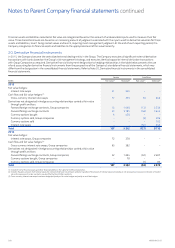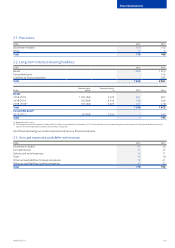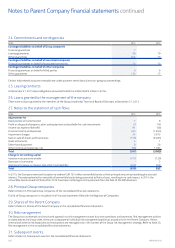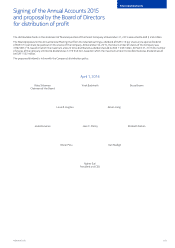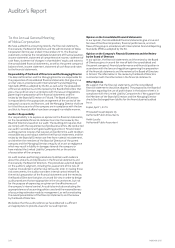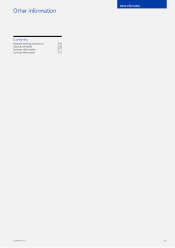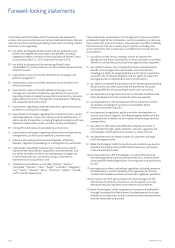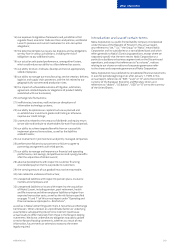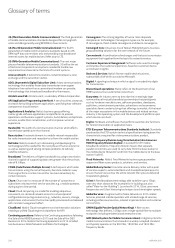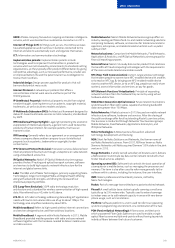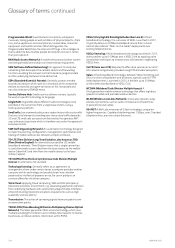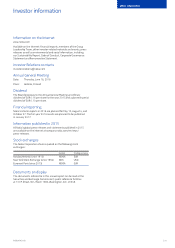Nokia 2015 Annual Report Download - page 212
Download and view the complete annual report
Please find page 212 of the 2015 Nokia annual report below. You can navigate through the pages in the report by either clicking on the pages listed below, or by using the keyword search tool below to find specific information within the annual report.210 NOKIA IN 2015
Programmable World: A world where connectivity will expand
massively, linking people as well as billions of physical objects—from
cars, home appliances and smartphones, to wearables, industrial
equipment and health monitors. What distinguishes the
Programmable World from the Internet of Things is the intelligence
that is added to data to allow people to interpret and use it, rather
than just capture it.
RAN (Radio Access Network): A mobile telecommunications system
consisting of radio base stations and transmission equipment.
SDN (Software Dened Networking): An approach to computer
networking that decouples the network control and forwarding
functions enabling the network control to become programmable
andthe underlying hardware to be abstracted.
SEPs (Standard-Essential Patents): Generally, patents needed
toproduce products which work on a standard, which companies
declare as essential and agree to license on fair, reasonable and
non-discriminatory (FRAND) terms.
Service Delivery Hub: Smaller service delivery centers, typically
focused on specic technology or language.
Single RAN: Single RAN allows dierent radio technologies to be
provided at the same time from a single base station, using a
multi-purpose platform.
Small cells: Low-powered radio access nodes (micro cells or picocells)
that are a vital element to handling very dense data trac demands.
3G and LTE small cells use spectrum licensed by the operator; WiFi
usesunlicensed spectrum which is therefore not under the operator’s
exclusive control.
SON (Self-Organizing Network): An automation technology designed
to make the planning, conguration, management, optimization and
healing of mobile radio access networks simpler and faster.
TD-LTE (Time Division Long Term Evolution, also known as TDD
(Time Division Duplex)): An alternative standard for LTE mobile
broadband networks. Time Division means that a single connection
isused alternately to carry data from the base station to the mobile
device (‘downlink’) and then from the mobile device to the base
station(‘uplink’).
TD-SCDMA (Time Division Synchronous Code Division Multiple
Access): An alternative 3G standard.
Technology licensing: Generally refers to an agreement or
arrangement where under certain terms a company provides another
company with its technology and possibly know-how, whether
protected by intellectual property or not, for use in products or
services oered by the other company.
Telco Cloud: Applying Cloud computing, SDN and NFV principles in
telecommunications environment, e.g. separating application software
from underlying hardware with automated, programmable interfaces
while still retaining telecommunications requirements such as high
availability and low latency.
Transmission: The action of conveying signals from one point to one
or more other points.
TWDM-PON (Time Wavelength Division Multiplexing Passive Optical
Network): The latest generation ber access technology, which uses
multiple wavelengths to deliver up to 40Gbps total capacity to homes,
businesses, and base stations. Also known as NG-PON2.
VDSL2 (Very High Bit Rate Digital Subscriber Line 2): A xed
broadband technology, the successor of ADSL. Launched in 2007,
ittypically delivers a 30Mbps broadband service from a street
cabinet(also called a “Fiber-to-the-Node” deployment) over
existingtelephone lines.
VDSL2 Vectoring: A xed broadband technology launched in 2011,
able to deliver up to 100Mbps over a VDSL2 line by applying noise
cancellation techniques to remove cross-talk between neighboring
VDSL2 lines.
VoLTE (Voice over LTE): Required to oer voice services on an all-IP
LTE network and generally provided using IP Multimedia Subsystem.
Vplus: A xed broadband technology, between VDSL2 Vectoring and
G.fast in terms of bandwidth and distances, typically used in FTTN
(ode) deployments. Launched in 2015, it delivers up to 300Mbps
andhas been standardized as VDSL2 35b.
WCDMA (Wideband Code Division Multiple Access): A
third-generation mobile wireless technology that oers high data
speeds to mobile and portable wireless devices.
WLAN (Wireless Local Area Network): A local area network using
wireless connections, such as radio, microwave or infrared links,
inplace of physical cables.
XG-FAST: A Bell Labs extension of G.fast technology, using even
higherfrequencies. Capable of delivering over 10Gbps, over 2 bonded
telephone lines, over very short distances.
Glossary of terms continued


